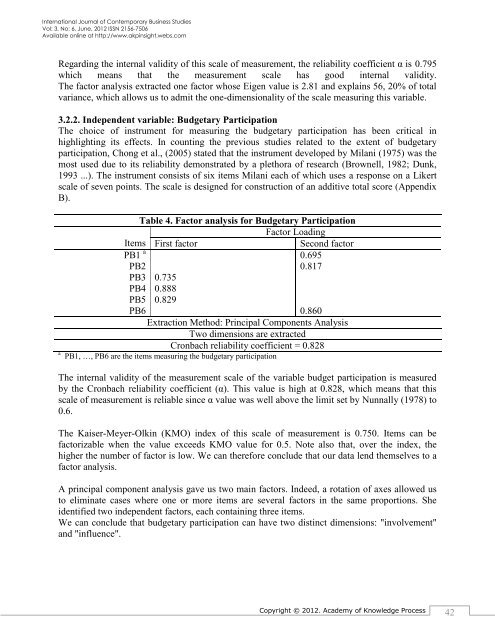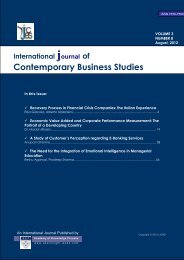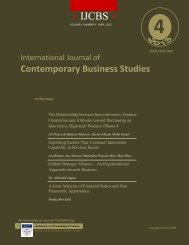International journal of Contemporary Business Studies
International journal of Contemporary Business Studies
International journal of Contemporary Business Studies
Create successful ePaper yourself
Turn your PDF publications into a flip-book with our unique Google optimized e-Paper software.
<strong>International</strong> Journal <strong>of</strong> <strong>Contemporary</strong> <strong>Business</strong> <strong>Studies</strong><br />
Vol: 3, No: 6. June, 2012 ISSN 2156-7506<br />
Available online at http://www.akpinsight.webs.com<br />
Regarding the internal validity <strong>of</strong> this scale <strong>of</strong> measurement, the reliability coefficient α is 0.795<br />
which means that the measurement scale has good internal validity.<br />
The factor analysis extracted one factor whose Eigen value is 2.81 and explains 56, 20% <strong>of</strong> total<br />
variance, which allows us to admit the one-dimensionality <strong>of</strong> the scale measuring this variable.<br />
3.2.2. Independent variable: Budgetary Participation<br />
The choice <strong>of</strong> instrument for measuring the budgetary participation has been critical in<br />
highlighting its effects. In counting the previous studies related to the extent <strong>of</strong> budgetary<br />
participation, Chong et al., (2005) stated that the instrument developed by Milani (1975) was the<br />
most used due to its reliability demonstrated by a plethora <strong>of</strong> research (Brownell, 1982; Dunk,<br />
1993 ...). The instrument consists <strong>of</strong> six items Milani each <strong>of</strong> which uses a response on a Likert<br />
scale <strong>of</strong> seven points. The scale is designed for construction <strong>of</strong> an additive total score (Appendix<br />
B).<br />
a<br />
Table 4. Factor analysis for Budgetary Participation<br />
Factor Loading<br />
Items First factor<br />
Second factor<br />
PB1 a 0.695<br />
PB2 0.817<br />
PB3 0.735<br />
PB4 0.888<br />
PB5 0.829<br />
PB6 0.860<br />
Extraction Method: Principal Components Analysis<br />
Two dimensions are extracted<br />
Cronbach reliability coefficient = 0.828<br />
PB1, …, PB6 are the items measuring the budgetary participation<br />
The internal validity <strong>of</strong> the measurement scale <strong>of</strong> the variable budget participation is measured<br />
by the Cronbach reliability coefficient (α). This value is high at 0.828, which means that this<br />
scale <strong>of</strong> measurement is reliable since α value was well above the limit set by Nunnally (1978) to<br />
0.6.<br />
The Kaiser-Meyer-Olkin (KMO) index <strong>of</strong> this scale <strong>of</strong> measurement is 0.750. Items can be<br />
factorizable when the value exceeds KMO value for 0.5. Note also that, over the index, the<br />
higher the number <strong>of</strong> factor is low. We can therefore conclude that our data lend themselves to a<br />
factor analysis.<br />
A principal component analysis gave us two main factors. Indeed, a rotation <strong>of</strong> axes allowed us<br />
to eliminate cases where one or more items are several factors in the same proportions. She<br />
identified two independent factors, each containing three items.<br />
We can conclude that budgetary participation can have two distinct dimensions: "involvement"<br />
and "influence".<br />
Copyright © 2012. Academy <strong>of</strong> Knowledge Process<br />
42
















